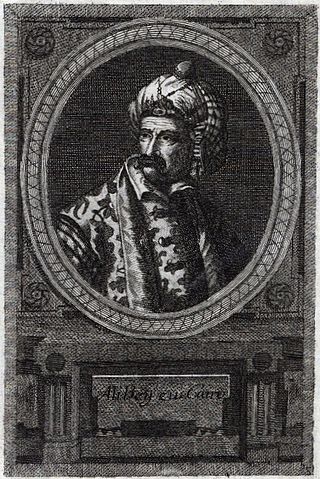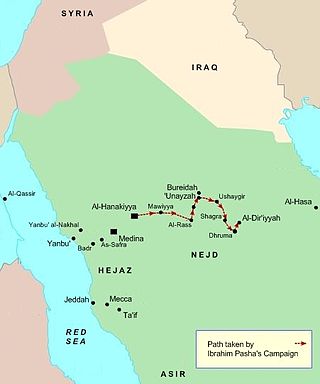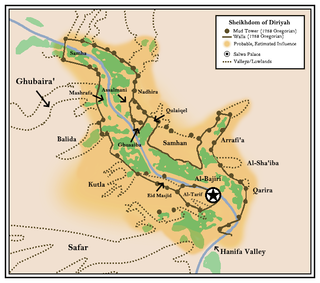
Ibrahim Pasha was an Egyptian general and politician; he was the commander of both the Egyptian and Ottoman armies and the eldest son of Muhammad Ali, the Ottoman Wāli and unrecognized Khedive of Egypt and Sudan. Ibrahim served as a general in the Egyptian army that his father established during his reign, taking his first command of Egyptian forces when he was merely a teenager. In the final year of his life, he was appointed Regent for his still-living father and became the effective ruler of Egypt and Sudan, owing to the latter's ill health. His rule also extended over the other dominions that his father had brought under Egyptian rule, namely Syria, Hejaz, Morea, Thasos, and Crete. Ibrahim pre-deceased his father, dying 10 November 1848, only four months after rising to power. He was succeeded as Regent by his nephew, Abbas, who upon Muhammad Ali's death the following year inherited the Egyptian throne.

Ali Bey al-Kabir was a Mamluk leader in Egypt. Nicknamed Jinn Ali and Bulut Kapan ("Cloud-Catcher"), Ali Bey rose to prominence in 1768 when he rebelled against his Ottoman rulers, making the Egypt Eyalet of the Ottoman Empire independent for a short time. His rule ended following the insubordination of his most trusted general, Abu al-Dahab, which led to Ali Bey's downfall and death.
The Wahhabi war, also known as the Ottoman–Saudi war, was fought from early 1811 until 1818 between the Ottoman Empire, its vassal the Eyalet of Egypt, and the Emirate of Diriyah, the First Saudi State, resulting in the destruction of the latter.

Murad Bey was an Egyptian Mamluk chieftain (Bey), cavalry commander and joint ruler of Egypt with Ibrahim Bey. He is often remembered as being a cruel and extortionate ruler, but an energetic courageous fighter.

Cezayirli Gazi Hasan Pasha or Hasan Pasha of Algiers, nicknamed Ejder-i Bahrî, was an Ottoman Grand Admiral (1770–90), Grand Vizier (1790), and general in the late 18th century.
The battle of Konya (Koniah) was fought on December 21, 1832, between Egypt and the Ottoman Empire, just outside the city of Konya in modern-day Turkey. The Egyptians were led by Ibrahim Pasha, while the Ottomans were led by Reşid Mehmed Pasha. The Egyptians were victorious.

The First Egyptian–Ottoman War or First Syrian War (1831–1833) was a military conflict between the Ottoman Empire and Egypt brought about by Muhammad Ali Pasha's demand to the Sublime Porte for control of Greater Syria, as reward for aiding the Sultan during the Greek War of Independence. As a result, Egyptian forces temporarily gained control of Syria, advancing as far north as Kütahya.

Sultan al-Atrash was a Syrian nationalist revolutionary who led the Great Syrian Revolt against the French colonial administration in Syria.
The Battle of Al-Safra took place in late 1811, when Tusun Pasha's forces engaged with Saudi forces led by Saud bin Abdulaziz. It was a resounding Saudi victory against the Ottoman forces.

The Battle of Medina took place in 1812, Following the Battle of Al-Safra, Tusun's forces began to deal with Saudi forces stationed in Medina.

The Najd Expedition was a series of military conflicts waged by Egypt on behalf of the Ottoman Empire from 1817 to 1818. It was part of the Ottoman–Saudi War that lasted from 1811 to 1818. The campaign of 1817/8 was led by Ibrahim Pasha, with the goal of capturing Diriyah and ending the First Saudi State by the order of the Ottoman sultan Mahmud II, through no real strategy other than brute force.

The siege of Diriyah took place in late 1818 at the end of the Wahhabi War of 1811–1818 during the Nejd Expedition.
Çelebi Ismail Pasha was an Ottoman statesman who held various administrative roles in his career as a high-level official in the Ottoman government.

Trabluslu Ali Pasha, also known as Cezayirli Ali Pasha or Seydi Ali Pasha, or Ali Burghol (Burghul) was an Ottoman statesman. He served as the Ottoman governor of Egypt from July 1803 to February 1804.
Husayn Abd al-Hadi was a sheikh of the Jabal Nablus region, head of the Abd al-Hadi clan of Arraba and a deputy of Ibrahim Pasha in Palestine. During Ibrahim Pasha's rule, he also served as the governor of Sidon Eyalet.
The Battle of Byssel was a military engagement between the Ottoman forces and the Saudi forces in Byssel. The Ottomans won a decisive battle, which broke Saudi power.
The Battle of Homs was fought on 8 or 9 July 1832 as part of the Egyptian–Ottoman War (1831–1833) at the eponymous Syrian town of Homs, 140 km north of Damascus, then in Ottoman territory. Ibrahim's Ottoman Egyptian troops routed the troops of Pasha of Aleppo, who lost all their artillery and transports.
The siege of Akka took place between 26 or 29 November 1831 and 27 May 1832 as part of the First Egyptian–Ottoman War in the eponymous Syrian town of Akka,—the capital of Sidon Eyalet,—also known as Acre, 125 km northwest of Jerusalem, which was then under Ottoman rule. Ibrahim Pasha's Ottoman Egyptian troops successfully besieged and stormed the troops of Abdullah Pasha.
The Battle of Beilan (Turkish:Belen) is a battle fought by the Egyptian army led by Ibrahim Pasha against the Ottoman army led by Hussein Pasha on July 29, 1832. This battle lasted for 3 hours, the Ottoman army was defeated in a crushing defeat and Ibrahim Pasha captured Belen.









